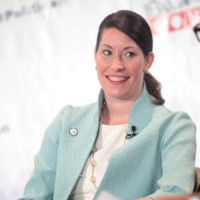Kentucky doesn’t have enough housing. On that even the state’s lawmakers can agree.
But the reasons for the shortages differ from community to community, exacerbated by natural disasters in some counties and a booming economy in others.

A task force, established by the GOP-dominated legislature earlier this year to better understand the state’s housing needs, has met twice this summer to hear from leaders of housing agencies and local elected officials about what they’re seeing in their communities. The task force is set to meet again Aug. 20 with three more meetings after that leading up to next year’s legislative session.
Co-chaired by Sen. Robby Mills, R-Henderson, and Rep. Susan Witten, R-Louisville, the task force is required to submit their findings and recommendations to the Legislative Research Commission by Dec. 1.
Here are the major takeaways from the two meetings:
Shortage straining renters and homeowners
Wendy Smith, deputy executive director at the Kentucky Housing Corporation, an independent public corporation that invests in housing projects, told the task force in June that Kentucky has a shortage of 206,000 housing units, but that shortage isn’t just for rental units. It also includes a lack of luxury homes and apartments that could help attract a workforce to communities.

The Kentucky Housing Corporation released the first phase of a report on the state’s housing gap earlier this year, with the second phase of the report coming sometime this month detailing a five-year projection of housing based on migration patterns, job announcements and the status of home starts.
Smith, citing the housing gap report, called the shortage “Kentucky’s most urgent issue” affecting all counties from rural areas to larger cities. She pointed to an increase in first-time homelessness as a symptom of a “market problem.”
“Because there’s not enough supply in the overall marketplace, we’re losing ground in serving the folks we try to serve. The overall marketplace needs more housing, and we need kind of a systematic approach that helps Kentucky be able to build and get brought to market more housing to meet our economic and population growth,” Smith said. “If we had enough supply — not even affordable, just enough supply — Kentucky would have lower average housing costs. Supply will bring down costs. That’s just, that’s economics, right?”
While the lack of homes for buyers is evenly distributed across incomes, Smith said, lower-income Kentuckians are disproportionately affected by the lack of rentals. And while the largest number of housing units needed are in Louisville, Lexington and Bowling Green, the need for housing is spread out across the state.

“I think there are a lot of folks who might think rural areas don’t have a housing crisis, and I can tell you, I am hearing from so many rural county judge executives and other leaders that they have a real need for more housing,” Smith said.
Disasters, new jobs and ‘local resistance’
Smith also testified in June that natural disasters destroyed and damaged housing, including roughly 5,000 housing units combined lost from a deadly tornado outbreak in December 2021 and deadly Eastern Kentucky floods in July 2022.
Damage from natural disasters have also increased home insurance and rental insurance costs, she said, referencing New York Times reporting that showed claims for losses in 2023 were larger in Kentucky than any other state, except Hawaii.
Another factor in some communities, she said, was housing strain brought on by economic growth, “local resistance” to building new housing and a lack of home builders.
She pointed out that many small builders “who did the lion’s share of construction in rural Kentucky,” quit during the Great Recession earlier this century. “They got out of business. They haven’t gotten back into it,” she said. “If they’re even trying, it’s hard for them to get access to lending.”
Elizabethtown Mayor Jeff Gregory testified in the July task force meeting alongside other local officials that the jobs and economic activity brought by building the BlueOval SK electric vehicle battery plants were creating “unintended issues” with housing.
Joe Reverman, the director of land use planning for Elizabethtown, said the city in the past has issued permits for about 100 housing units every year; over the past two years, that number has spiked to roughly 2,000 units. Reverman said keeping up with the infrastructure provided to the homes has been a major challenge.
- SUBSCRIBE: Sign up for our newsletters
“With the previous state of development, we’ve been able to kind of plan and provide infrastructure in places where it was needed,” Reverman said. “But when you increase that tenfold, just in a short amount of time, it’s really difficult to build that infrastructure in advance.”
Another local official in rural Marshall County also testified that the lack of available utilities, including high-speed internet access, limited housing growth.
Boone County Judge-Executive Gary Moore also said that local control of housing development is going to be “huge,” saying that some people in his county are more resistant to building affordable, lower-income housing.
“There’s places that people definitely understand the need for low-income housing and may be willing to consider it,” Moore said. “Other parts of the county, they know we need it — but ‘not in my backyard.’”
A desire for denser ‘middle’ housing
Smith, the Kentucky Housing Corporation deputy director, and local officials also spoke about the need for denser housing, particularly in cities, to help increase the housing supply.
Smith said the state generally lacked “middle housing,” explaining that zoning laws in Kentucky usually only allowed for the building of single-family homes or apartment complexes — and nothing in between. The federal funding the housing corporation gets, she said, is also usually geared toward building single-family homes and apartment complexes. She said the building of other types of housing ranging from duplexes, triplexes and more has almost “zeroed out.”
Louisville Mayor Craig Greenberg, who testified in July, said density could also mean taking single-family homes and turning them into duplexes, or adding more housing density with major transportation corridors for people to have access to transportation routes. He said given the limited amount of land to build new homes in Jefferson County, building more townhouses, duplexes, triplexes and other dense housing could be a solution.
“When you think of the way the world is evolving, people are looking to live in different ways than they have historically,” Greenberg said. “From an architectural standpoint, there is no visible added density, but maybe two families just live on smaller lots than what historically has been the case.”
Elizabeth Strojan, the new executive director of the Louisville Metro Housing Authority, described housing density from her experience of living in the Highlands, a neighborhood on the east side of Louisville.
“So you might walk past a single-family home, and the home next door is a duplex. And the home next door is an apartment building,” Strojan said. “It makes for a beautifully diverse neighborhood, so density can look different depending on what the context is.”
Greenberg said some of the millions of dollars in funding the legislature appropriated to the city is being used to convert downtown office space into housing.
What’s next for the housing task force?
When Mills, the co-chair of the task force, began the second meeting of the study group in July, he emphasized that the purpose of the committee wasn’t to “create or develop legislation” and that lawmakers wanted to hear about housing challenges around the state.
Rep. Randy Bridges, R-Paducah, a member of the task force who was the primary sponsor of the bipartisan resolution to create the interim committee, told the Lantern that while he can’t speak for Mills, he thinks the committee can find other ways to make changes in housing through the regulations, either by creating new ones or modifying existing.
“We don’t want to make a knee jerk reaction and come up with statutes that will be counterproductive or have unintended consequences,” Bridges said, who works as a Paducah real estate agent. “What we do realize is some of these may not require new laws.”
Housing advocates and nonprofit home builders had called on lawmakers to invest $200 million into state housing trust funds, citing a flush state “rainy day” fund, to provide a reliable source of investment for housing construction, especially to rebuild housing in areas of the state recovering from natural disasters. GOP legislative leadership did not heed those calls, instead providing funding for specific housing projects instead.
Bridges said he didn’t want to appear to be “turning a deaf ear” to those advocates, saying that he wants to keep an open mind about possible solutions. But he said large appropriations for housing were probably not “in the list of urgency” on what he believed lawmakers would do.
“Where are we going to get the most return on our investment?” Bridges asked.
This article is republished under a Creative Commons license from Kentucky Lantern, which is part of States Newsroom, a network of news bureaus supported by grants and a coalition of donors as a 501c(3) public charity. Kentucky Lantern maintains editorial independence. Contact Editor Jamie Lucke for questions: info@kentuckylantern.com. Follow Kentucky Lantern on Facebook and Twitter.
Liam Niemeyer covers government and policy in Kentucky and its impacts throughout the Commonwealth for the Kentucky Lantern. He most recently spent four years reporting award-winning stories for WKMS Public Radio in Murray.






